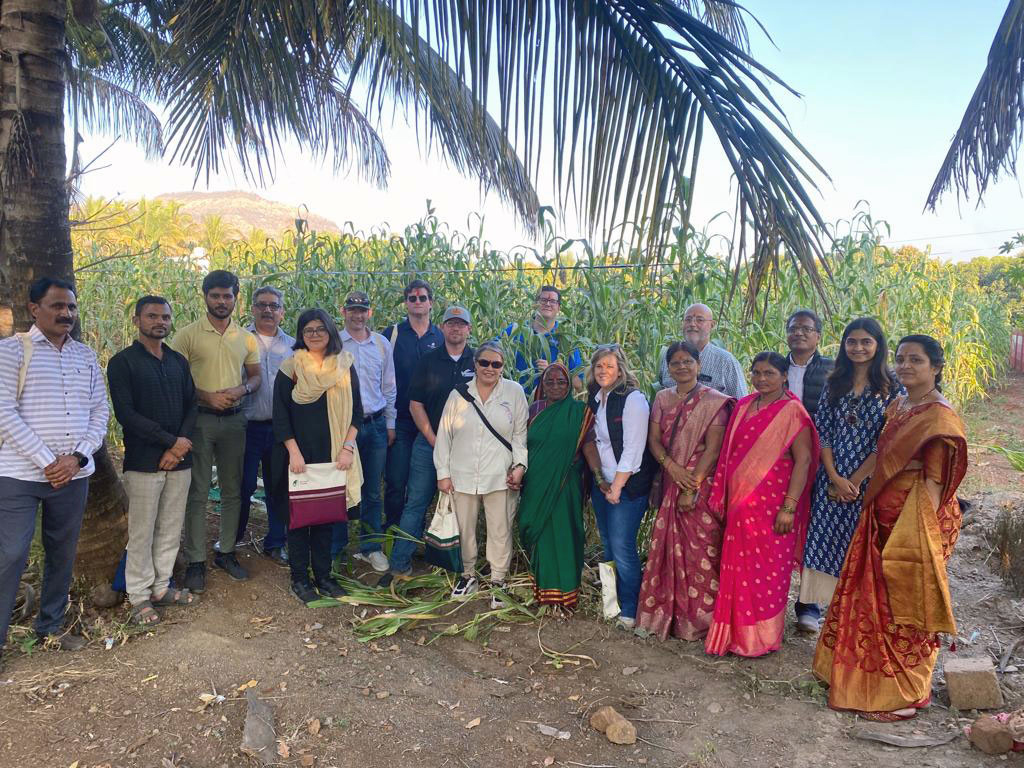U.S. sorghum industry journeys to India to tap into new markets

Grain sorghum or jowar, as it is called in India, is a valuable commodity to the more than 1.4 billion people who inhabit India. In order to create opportunities for United States sorghum in India, an exploratory trade mission to the country was funded primarily by the United Sorghum Checkoff Program, but also included the U.S. Grains Council and National Sorghum Producers.
The trip took place Jan. 13 to 20 and meetings were held in Delhi, Ahmedabad, Himatnagar, Mumbai, Pune, and Satara.
“The meetings focused on creating opportunities for U.S. sorghum for human consumption, industrial starch extraction, feed grain applications and ethanol production,” said Norma Ritz Johnson, executive director of Sorghum Checkoff. “Despite India imposing a 50% tariff on U.S. sorghum and the absence of a completed Pest Risk Assessment by both the Indian and U.S. governments, the demand for food products in India is on the rise. This initiative aims to examine and emphasize the potential role sorghum can and should play in offering a dependable and advantageous source of food and feed.”
Participants included Johnson; Florentino Lopez, consultant at Creando Mañana; Adam Schindler, past chairman of the board at United Sorghum Checkoff Program; Craig Meeker, Meeker Farms in Wellington, Kansas; Shelee Padgett, director of emerging markets at the United Sorghum Checkoff Program; Jace Hefner, manager of global trade at U.S. Grains Council; Reece Cannady, regional director of South Asia at U.S. Grains Council; Amit Sachdev, regional consultant at U.S. Grains Council; Nayantara Anandani Pande, marketing specialist at U.S. Grains Council; and Sonjoy Mohanty, senior ethanol advisor at U.S. Grains Council.
The U.S. sorghum industry has identified India as an ideal market for trade expansion for several reasons. India has a strict ban on genetically modified organisms and since all sorghum is non-GMO, it meets India’s requirements. Additionally, the country has produced and utilized sorghum for centuries, so India is already culturally familiar with the commodity. India produces approximately 3 to 4 million metric tons of grain sorghum a year. However, its use and demand in the country is expected to expand.

“India is the world’s third largest sorghum producer, behind the U.S. and Nigeria,” said Bryan Jernigan, director of communications at the U.S. Grains Council. “However, among the top five sorghum producing countries, India has the lowest yield, which is projected at 17 bushels per acre this coming year—compare that to the U.S., which is currently sitting at 52 bushels per acre for their 2023 final projections. So, for them to meet their production totals, they have to plant large swaths of land, and they are.”
Jernigan said at one time India had the most dedicated acres to sorghum in the world, but with increases in rice, sugar and corn prices, the number of sorghum acres has been reduced. Right now, India is the second largest planter of sorghum today, behind Nigeria. Jernigan said India dedicates roughly 1.5 times the acreage to sorghum versus what the U.S. does. India is projected to raise roughly 4.4 million metric tons or 173.2 million bushels during the 2023-2024 marketing year.
“When you look at the agrarian population, which makes up 50% of the population and has an average farm size of 2.5 acres, the population that relies on sorghum for sustenance and/or sales is enormous,” Jernigan explained. “Never forget, India is the most populous country in the world, so when you’re looking at population economics, the proportions can be hard to grasp.”
Uses of sorghum in India

India’s historical use of sorghum has been in human diets, but it is also used for livestock feed, biofuels and industrial uses. Johnson said this ancient grain is gaining traction as a healthy and versatile food option, especially for snacks and specialty products.
“A key item to remember is that roughly 40% of the population is vegetarian,” Johnson said. “As such, pulses and grains are very important in providing additional protein. Sorghum helps fill this need. A serving of cooked whole-grain sorghum provides more than double the amount of protein as a serving of quinoa.”
As far as livestock feed, the sorghum grown in India has some shortcomings. It is high in tannin, making it a less desirable feed source for animals. Tannins are complex chemical substances derived from phenolic acids and are often found in plants. High tannin feeds can lead to reduced feed intake, fiber digestibility and lower animal performance.
“When we spoke with animal feeders, they were entirely aware of India’s high tannin sorghum, and they had no idea that a non-tannin variety existed in the U.S.,” Jernigan said. “That will give the U.S. a sincere marketing advantage, particularly in animal feed.”
India is already utilizing sorghum for ethanol, but this commodity has become even more attractive to the biofuels industry with India’s recently mandated E20 blend policy, which states all petrol must contain 20% ethanol by 2025 or 2026. This is part of India’s push to reduce reliance on fossil fuels. The Indian government also plans to up the ethanol-blended policy to 30% by 2029 or 2030. Sorghum in the ethanol sector was discussed on the trade mission and Jernigan said the biggest takeaway was sorghum’s low water consumption.
“India is beginning to, like the rest of the world, have concerns about water,” he said. “If the exploding ethanol production in India can find feedstocks that consume less water, they would be thrilled to have them. U.S. sorghum fits that bill.”
The exploratory trade mission was also able to meet with India’s starch processors and promote sorghum as an ideal option for starch extraction. Johnson said the delegation presented prior research funded by USCP at the University of Illinois that demonstrates sorghum’s superior starch yields compared to Indian corn, which is currently the sole raw material for Indian starch manufacturers.

How will U.S. sorghum figure into India’s future
In the future, India is expected to face a coarse grain shortage due to growing population, less rainfall and other factors. Jernigan said as coarse grain supply runs thin, sorghum tariffs could be lowered to help meet the growing need for non-GM feedstock in India. Both Jernigan and Johnson said U.S. sorghum could play a major role in satisfying India’s sorghum needs down the road.
“India’s growing middle class and biofuel aspirations are creating a unique opportunity for U.S. sorghum exports,” Johnson said. “Demand for food and ethanol is expected to outpace grain production in India, potentially leading to a long-term shortfall. This presents a significant market opportunity for U.S. sorghum as a reliable and sustainable alternative grain source.”
Johnson said the U.S. sorghum industry will keep the lines of communication open with India and provide industry samples and lab analysis of U.S. sorghum to demonstrate the value of our sorghum. Jernigan said it is important to remember this trip was one of the initial steps in the long game of sorghum in India.
Sign up for HPJ Insights
Our weekly newsletter delivers the latest news straight to your inbox including breaking news, our exclusive columns and much more.
“The opportunity will come knocking one day, and the industry must be ready,” he said. “By doing the footwork today, it puts us in position to grab a potentially game-changing market down the road. I think you’ll see quite a bit of research coming from the industry to promote U.S. sorghum as a superior input in India, whether it be in animal feed, food, starch processing or ethanol manufacturing. This is the research we need today for this market of the future.”
Johnson said expects challenges, such as agreeing on phytosanitary measures, piloting India’s import regulations and competing against domestic production, which will demand collaborative efforts from U.S. sorghum producers, policymakers and Indian stakeholders. She described the future steps with India as a complex process, but the prospective returns of accessing the Indian market make it a valuable endeavor for the U.S. sorghum industry.
“Expanding sorghum markets abroad, particularly in India with its growing population, holds great promise,” Johnson explained. “The trade mission is crucial for addressing trade barriers and showcasing sorghum’s potential role in meeting the rising global demand for sustainable food sources. With its non-GMO status and adaptability, sorghum is well-positioned to play a key role in feeding a growing world population. The success of the mission can pave the way for lasting collaborations and economic growth in the global marketplace.”
Lacey Vilhauer can be reached at 620-227-1871 or [email protected].



